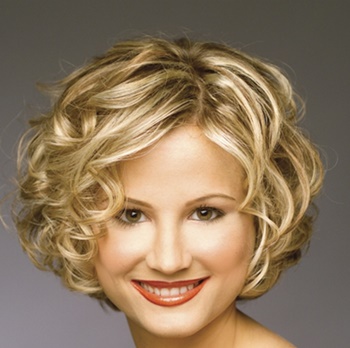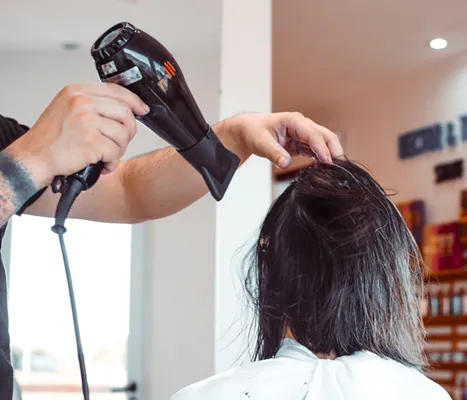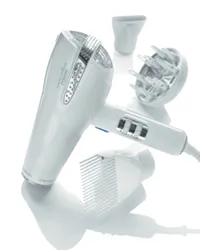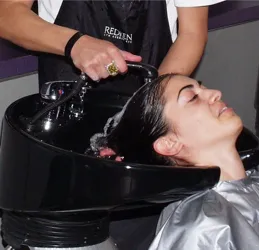
Why Is Hair Drying Damaging To Hair?
Question
Dear Karen,
 Why Is Hair Drying Damaging To Hair? Image Courtesy Of Tom Carson Photography - Total Image Magazine - Hair By Kenneth's Hair With Style - Metairie, Louisiana - All Rights Reserved
Why Is Hair Drying Damaging To Hair? Image Courtesy Of Tom Carson Photography - Total Image Magazine - Hair By Kenneth's Hair With Style - Metairie, Louisiana - All Rights ReservedI wet wash and blow dry my naturally wavy hair 4-5 times per week. Then I use a paddle brush to blow dry my hair straight.
Sometimes I use a hot iron to quickly touch up any hair sections which might still have any waves.
Recently I've noticed a lot of hair breakage around my hairline and along the top of my head.
When I asked my hairdresser if she could help me figure out what was causing the breakage, she told me it was from using a hot blow dryer on my hair several times a week.
She also said the hot iron may be causing damage, but it was most likely from the frequent blow drying.
My hair is highlighted and lowlighted.
I thought maybe the highlighting might be causing the breakage, but my hairdresser said it is from the frequent blow drying.
I'm confused. Why is hair drying damaging to the hair? What can I do to stop the breakage without giving my hair dryer?
Suze
Answer
Dear Suze,
 Why Is Hair Drying Damaging To Hair? Image Courtesy Of Tom Carson Photography - Total Image Magazine - Hair by Jennifer & Co. - Mentor, Ohio - All Rights Reserved
Why Is Hair Drying Damaging To Hair? Image Courtesy Of Tom Carson Photography - Total Image Magazine - Hair by Jennifer & Co. - Mentor, Ohio - All Rights ReservedThere might be several things contributing to your current hair breakage which may or may not include the following issues:
1. Cuticle Layer Swelling Occurs During Any Exposure To Water
Whenever you get your hair wet during a cleansing session, the outside cuticle layers of your hair follicles, which are designed to protect your hair from damage, open and swell.
Hair cuticle layers will swell when drenched with water. They may open even further when using hot water.
It's important to avoid wet washing your hair more frequently than necessary because the opening and closing of the cuticle will always occur, triggering more damage.
To minimize the damage from the water causing the cuticle to swell, avoid hot water. Finish any wet washing sessions with cool/cold water to close the cuticle layer and prevent air moisture from entering the hair after drying.
2. Cuticle Shape May Be More Open, Allowing More Water To Enter
Your natural cuticle shape is wavy/ This makes it more at risk for allowing moisture in the hair. This moisture originates from natural humidity.
If it's absorbed into your cuticle layers after your hair is dried, it will cause your cuticle layers to swell, which results in damage and frizz.
Any cuticle layer swelling experiences will damage the hair. Ironically, hair may feel rough, frizzy, dry, and damaged because the cuticle layers have holes and breaks which allow water from the air to saturate strands.
When hair gets wet, it swells. When it dries, it unswells. At that point, depending upon the humidity in the air, your hair will attempt to re-balance and will attract water into the hair shaft. Any type of cuticle opening or swelling may damage hair.
2. Chemical highlighting and low lighting also open the cuticles and cause them to swell, damaging the cuticle.
3. Heat damage from hot water, blow dryer heat, and hot styling tools (hot irons, rollers, or similar).
Heat is damaging to the hair by causing dehydration. It triggers the loss of moisture. It also creates a disruption to the hair's natural lipid layers. How? By degrading its protein structure.
What Should You Do?
1. Only wet-wash hair in lukewarm water as often as necessary to minimize cuticle disruption.
2. Use a rinse-out conditioner to help block humidity from entering the hair cuticle layer.3. Finish with a cool/cold final rinse to help close the cuticle layer even further.
4. Use a microfiber towel or 100% cotton t-shirt to blot hair. Rubbing or ruffling wet hair with rough towels is damaging since hair is more fragile when wet, and cuticle layers can be rubbed off.5. Protect your hair with a good leave-in conditioner or similar styling product before drying or styling to minimize additional cuticle layer disruption and ultimate moisture absorption.
6. In between wet washing sessions, use a tiny bit of coconut oil or a similar formula. Lightly apply to the outside layer of hair to block water absorption from the environment, which may cause the cuticle layers to swell, frizz, and be more prone to damage.Managing cuticle layer disruptions appropriately, applying the appropriate humidity-blocking products, and utilizing the appropriate conditioning products will make all the difference for long-term hair recovery.
Best wishes to all.By submitting your question, you grant full permission to HairBoutique.com to publish it. Due to the volume of mail we receive, Karen regrets that she cannot respond to every question personally.
To AskKaren a question, send an e-mail to: askkaren@hairboutique.com
Social Media Network Information
Please follow us on Twitter at: https://Twitter.com/HairBoutique. I look forward to meeting new people from all walks of Twitter and learning from their Tweets.

















